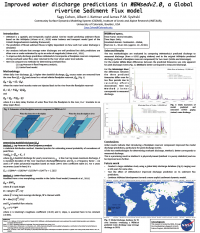CSDMS 2011 annual meeting poster Sagy Cohen
Improved water discharge predictions in WBMsedv2.0, a Global riverine Sediment Flux model
Albert Kettner, CSDMS - INSTAAR, Univ. of Colorado Boulder Colorado, USA. kettner@colorado.edu
James Syvitski, CSDMS - INSTAAR, Univ. of Colorado Boulder Colorado, USA. james.syvitski@colorado.edu
Abstract:
WBMsed is a spatially and temporally explicit global riverine model predicting suspended and bedload sediment fluxes based on the WBMplus water balance and transport model (part of the FrAMES biogeochemical modeling framework). The model incorporates climate input forcings to calculate surface and subsurface runoff for each grid cell. The prediction of fluvial sediment fluxes is highly dependent on how well its transport medium, riverine water, is simulated. Our analyses indicate that average water discharges are well predicted by the WBMplus model. However, daily freshwater predictions are often over or under predicted by up to an order of magnitude, significantly affecting the accuracy of sediment flux simulation capabilities of WBMsed and indicating that certain hydrological processes are less captured within the model. One of these processes could be temporal storage of water discharge on floodplains, dampening the water hydrograph significantly. In WBMsedv2.0 we incorporate a floodplain reservoir component to improve daily water discharge simulations. The Floodplain reservoir component is used in WBMsedv2.0 to store overbank water flow which are refurbished back to the river once its water level has subsided. Here we compare two methods for determining overbank flow: (1) the log-Pearson III (flood frequency analysis) 5-year maximum discharge recurrence and (2) an empirical relationship between mean river discharge and river width and bank height.
* Please acknowledge the original contributors when you are using this material. If there are any copyright issues, please let us know and we will respond as soon as possible.

